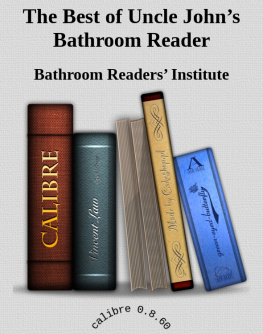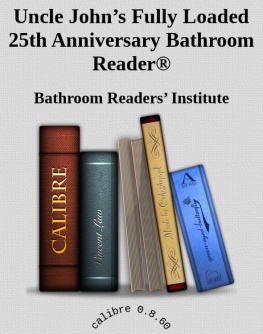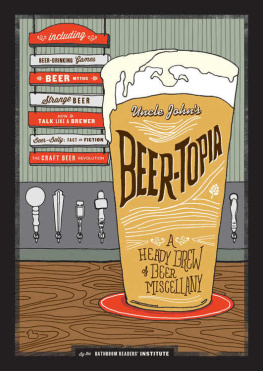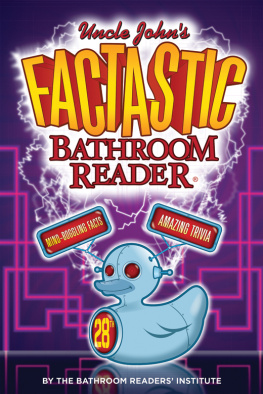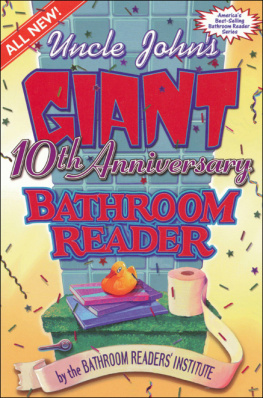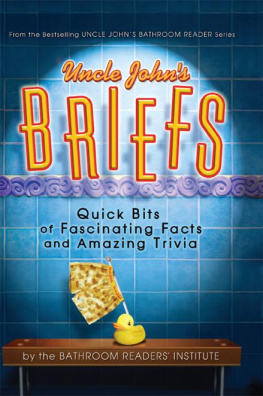It seems appropriate to begin this volume with a little background on the room youre probably sitting in right now.
T HE FIRST BATHROOM
The idea of a separate room for the disposal of bodily waste goes back at least 10,000 years (to 8000 B.C.). On Orkney, an island off the coast of Scotland, the inhabitants, who lived in stone huts, created a drainage system that carried the waste directly into a nearby stream.
THE FIRST SOPHISTICATED PLUMBING
Bathtubs dating back to 2000 B.C. have been found on the island of Crete (where theres also evidence of the first flush toilet). Considering that they were built almost 4,000 years ago, the similarity to modern baths is startling.
Around 1500 B.C., elite Egyptians had hot and cold running water; it came into homes through a system of copper tubing or pipes.
THE FIRST SOCIAL BATHING
The ancient Romans took their bathing seriously, building public facilities wherever they settledincluding London. The more elaborate of these included massage salons, food and wine, gardens, exercise rooms, and in at least one case, a public library. Coed bathing was not uncommon, nor frowned upon.
A STEP BACKWARD
As Christianity became increasingly powerful, techniques of plumbing and waste disposaland cleanliness in generalwere forgotten; only in monasteries was this knowledge preserved.
For hundreds of years, people in Europe basically stopped washing their bodies, in large part because nudityeven for reasons of health or hygienewas regarded as sinful by the Church.
In some cases, a reverence for dirt arose in its place. St. Francis of Assisi, for example, believed dirtiness was an insignia of holiness.
Upper-class citizens tried to cover up the inevitable body odors with clothes and perfume, but the rest of the population suffered with the rank smells of filth.
First American to have plumbing installed in his home: Henry Wadsworth Longfellow, 1840.
CHAMBER POTS AND STREET ETIQUETTE
Until the early 1800s, Europeans relieved themselves in chamber pots, outhouses, streets, alleys, and anywhere else they happened to feel like it.
It was so common to relieve oneself in public that people were concerned about how to behave if they noticed acquaintances urinating or defecating on the street. Proper etiquette: Act like you dont see them.
Chamber pots were used at night, or when it was too cold to go outside. Their contents were supposed to be picked up once a day by a waste man, who carted the communitys leavings to a public cesspool.
But frequently, the chamber pot was surreptitiously dumped at night, which made it dangerous to go strolling in the evening.
DISEASE AND CHANGE
The lack of bathing took an enormous toll on the European in the Middle Ages, as epidemics caused by unsanitary living conditions became rampant. But in the 1830s, a London outbreak of choleraa disease the English believed could only be contracted by inferior racesfinally convinced the government to put its power behind public sanitation. Over the next 50 years, the British built new public facilities that set the pace for the rest of the world.
THE MODERN FLUSH TOILET
The modern flush toilet was invented by an Englishman named Alexander Cumming in 1775. Cummings toilet emptied directly into a pipe, which then carried the undesirable matter to a cesspool. Other toilets had done this, too, but Cummings major improvement was the addition of a stink trap that kept water in the pipe and thus blocked odor.
Note: It is widely believed that an Englishman named Thomas Crapper invented the toilet. Thats probably a myth. (See .)
HEAD FOR THE JOHN
In the mid-1500s in England, a chamber pot was referred to as a Jake. A hundred years later, it became a John, or Cousin John. In the mid-1800s, it was also dubbed a Joe.
The first known contraceptive was crocodile dung, used by Egyptians in 2000 B.C.
That still may not be the source of the term John for the bathroomit may date to the 1920s, when Mens and Ladies rooms became common in public places. They were also referred to as Johns and Janespresumably after John and Jane Doe.
The term potty comes from the pint-sized chamber pot built for kids.
BATHROOMS
The bathroom we knowwith a combination toilet and bathdidnt exist until the 1850s. And then only for the rich.
Until then, the term bathroomwhich came into use in the 1820s or 1830smeant, literally, a room with a bathtub in it.
A FEW AMERICAN FIRSTS
First American hotel with indoor modern bathrooms: The Tremont House in Boston, 1880s.
First toilet in the White House: 1825, installed for John Quincy Adams (leading to a new slang term for toileta quincy).
First city with modern waterworks: Philadelphia, 1820.
First city with a modern sewage system: Boston, 1823.
THE FIRST TOILET PAPER
In ancient times, there was no T.P. Well-to-do Romans used sponges, wool, and rosewater. Everyone else used whatever was at hand, including sticks, stones, leaves, or dry bones. In the Middle Ages, nobles preferred silk or goose feathers (still attached to the pliable neck).
Toilet paper was introduced in America in 1857, as a package of loose sheets. But it was too much like the paper Americans already usedthe Sears catalog. It flopped.
In 1879, an Englishman named Walter Alcock created the first perforated rolls of toilet paper. A year later, Philadelphias Scott Brothers saw the potential inthe U.S. for a product that would constantly have to be replaced. They introduced Waldorf Tissue (later Scott Tissue), which was discreetly sold in plain brown wrappers. The timing was rightby then there were enough bathrooms in America to make toilet tissue a success.
Some starfish have eight eyesone at the end of each leg.
If our mail was any gauge, the most controversial tidbit in the first Bathroom Reader was our comment that the widely accepted notion that Thomas Crapper invented the toilet is a hoax. Readers sent all kinds of evidence proving that Crapper was real. But was he? Lets take a closer look.
F LUSHED WITH PRIDE
The name Thomas Crapper appears to have been unknown among bathroom historians until 1969, when English writer Wallace Reyburn published a 99-page book entitled Flushed with PrideThe Story of Thomas Crapper.
This biography (which Reyburns publisher calls The Little Classic of the Smallest Room) begins this way:
Never has the saying a prophet is without honor in his own land been more true than in the case of Thomas Crapper. Here was a man whose foresight, ingenuity, and perseverence brought to perfection one of the great boons to mankind. But is his name revered in the same way as, for example, that of the Earl of Sandwich?
Of course not. Not, anyway, until Reyburns book was published.
CRAPPER, THE MAN
According to Reyburn:
Tom Crapper was born in 1837 and died in 1910.
He is responsible for many toilet innovationsincluding, as bathroomologist Pat Mitchell puts it, the toilets that flush in a rush seen in public restrooms today, and thetrap in plumbing that keeps sewer gas from rising into our homes.
But the most important of Crappers alleged accomplishments was Crappers Valveless Water Waste Preventer, an apparatus that made flushing more efficient. Cleaning Management magazine calls it the forerunner of our present-day flush system.
For this contribution, Crapper was supposedly appointed the Royal Plumber by King Edward VII.
In 1980, the yellow pages accidentally listed a Texas funeral home under Frozen Foods.

